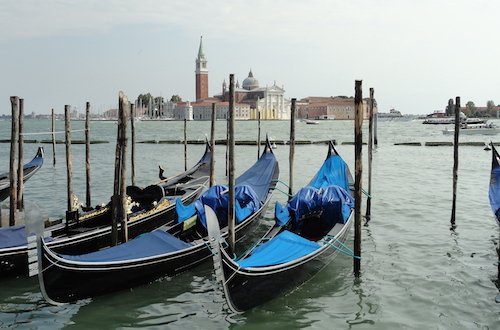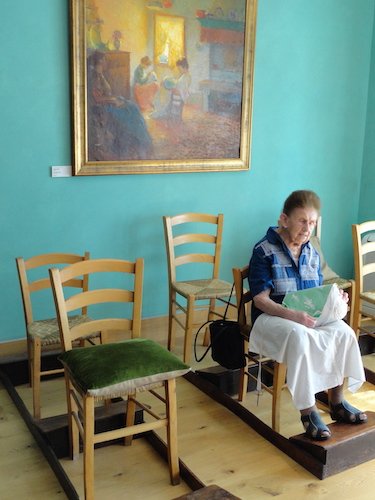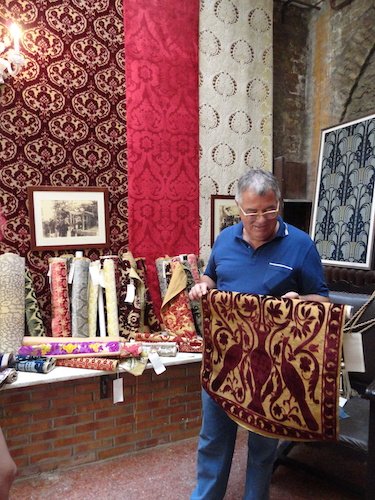Adventures in Venice
In my last post I shared my experiences studying silk weaving on jacquard looms at the Lisio Foundation in Florence, Italy. While we worked very diligently during our three-week course, we still managed to find plenty of time to explore Florence, go to museums, and of course, eat plenty of pasta and gelato.
But in addition to that, a special outing was planned for us by Barbara Setsu Pickett to take the train up to Venice for three days of adventures. I had spent a few days in Venice as part of a six-month solo backpacking trip through Europe on a shoestring budget when I was a naïve 21-year old in the mid-1970’s. I got hopelessly lost in the labyrinth of canals and bridges and wasn’t sure if I would find my way back to my youth hostel that night. One of the many pleasures of traveling in Italy with Barbara was that she knows her way around, as well as many secret little places that we probably wouldn’t have found otherwise.
After getting up early and spending the morning on the train we had the rest of the afternoon free to have a nice lunch and explore the city. We followed Barbara along all the winding streets, across the bridges, and down little alleyways, secure in the knowledge that she knew where she was taking us. I was entranced with all of the beautiful shop windows whose displays made me want to go in and buy everything inside.
The next day Barbara and I took the vaporetto, or public water taxi, to visit the islands off the coast of Venice. We had a brief stop at Murano, which is famous for its glassmaking, and then motored on to Torchello, which is a lovely, peaceful island with an 11th century basilica. After an hour or two wandering around there we got back on the vaporetto and traveled over to the island of Burano, which is famous for its lacemaking.
At the Lace Museum we saw an exhibit of a fractal lace project, and there was also a space where local women could come to make and demonstrate bobbin lace. This woman was 93 years old, and still making lace without wearing glasses.
Barbara and I had a special event planned for that evening. A couple months before our trip she contacted me and asked whether I might be interested in joining her to see an opera at La Fenice opera house. Of course! We had gone to the Metropolitan Opera in New York when I was in graduate school and we occasionally make it to the Santa Fe opera when she visits in the summer, and it is always a wonderful experience.
But first we had to walk through Venice to the neighborhood where the opera is located because there was a regatta race going on in the canals and the vaporetto service was closed.
This meant getting to see lots of parts of Venice that I hadn’t been in before. We found a nice outdoor trattoria near the opera and had a lovely relaxing dinner. I remarked on how wonderful is was to be at this point in life when we could enjoy these finer things in life, rather than being alone and half-starved, as I had been nearly forty years earlier on my previous visit to Venice.
And then on to the opera! When we bought our tickets online back at home they were in the lowest price tier and we had no real idea of where we would be seated. La Fenice is a classic European opera house and the setting is stunning. After gawking our way through the entryway and up several flights of stairs we were shown to box seats close to the center in the fourth tier. This was way beyond my wildest dreams.
I felt like royalty as we watched an exceptional rendition of La Traviata updated into a modern setting. I found myself in tears as the curtain came down, as much from the entirety of the experience as from the story in the opera itself.
The following day was our ‘work’ day. In the morning we walked to the Tessitura Luigi Bevilacqua weaving workshop, which was begun in the year 1499 and has been run by members of the Bevilacqua family since that time. We were met by Alberto Bevilacqua, who was clearly old friends with Barbara, and he gave us a tour of the facilities and the textiles woven there. In a room that was used to house warping equipment there were floor-to-ceiling shelves stacked with what looked like centuries-worth of cylinders of cards that could be used again and again to repeat previous patterns.
Just as at Lisio, there were a number of looms all set up with warps for weaving velvet, but with far more primitive lighting conditions.
The loading dock for receiving goods and shipping out finished textiles opened directly onto the canal.
The walls of the showroom were covered with examples of textiles and historic photographs and bolts of available textiles were propped up and lying on shelves.
One particularly beautiful historic textile had the logo and signature of the Bevilacqua workshop woven into velvet.
After spending a couple hours at Tessitura Bevilacqua we took a break for lunch. Afterwards we paid a visit to the Rubelli showroom, to see the upscale fabrics which are designed and machine-woven for home furnishings and accessories. The showroom is located in a beautiful historic palace with a balcony overlooking one of the canals.
We had a couple hours left before we had to catch our evening train back to Florence. We treated ourselves to a final Venetian gelato and were serenaded by a cello player in one of the piazzas. It had been a whirlwind couple of days, but we returned to Lisio refreshed and full of new inspiration.















